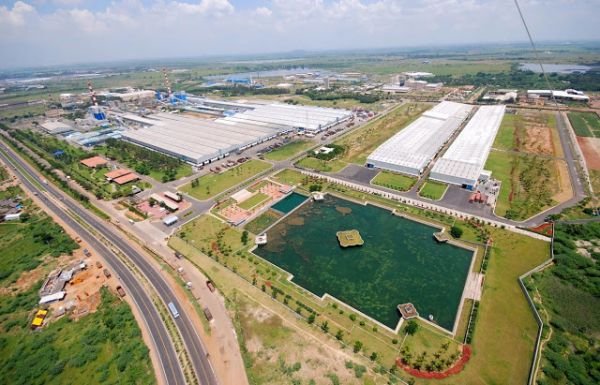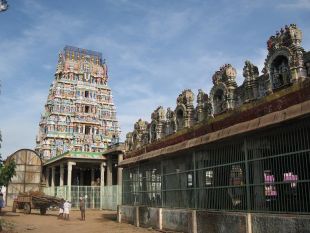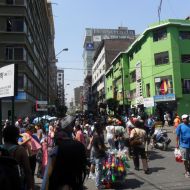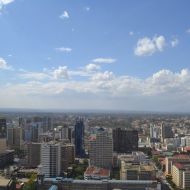Where the New India Rises, a Highway Divides Eras and Economies

The Saint Gobain glass factory with the NH4 highway running past it. Photo credit: Shanthi Babu
About 45 kilometers down the smooth, four-lane NH4 highway toward Bangalore, the large cooling towers of the Saint Gobain glass factory rise. Huge signs bearing the names of multinational corporations soon follow: Nokia, Hyundai, Foxconn. Home to some of the largest manufacturing facilities in the world, the Chennai suburb of Sriperumbudur is touted as one of Tamil Nadu’s astonishing success stories with investments of more than $2 billion USD and goods that are exported throughout the world.
Then, on the right, quite abruptly, a rutted track leads off the highway, down into a town filled with people who sold their land to the government long ago. This is what Sriperumbudur looked like before the factories arrived — a typical village. Land was available at Rs 4,000 to Rs 5,000 ($73 to $92 USD) an acre, which villagers would beg you to buy. Formal employment was virtually nonexistent. “The first major establishment was the Coromandel Country Club, where it was a matter of pride to be employed,” says Suhasini Fredrick, editor of the fortnightly Sriperumbudur News.
To cross the NH4 Chennai-Bangalore highway at Sriperumbudur today is to travel from a semi-rural township on one side to a massive global manufacturing hub on the other. A few meters of pavement are all that separate Flextronics, Samsung, Hwashin, Mitsubishi, BMW and a host of smaller units that feed goods and services to these giants from a place where unelected local leaders still rule the roost, food comes from the ground and infrastructure is in dire need of an update.

Before the 1990s, Sriperumbudur was obscure, known mainly for its famous temple.
Before the 1990s, the only people who had heard of Sriperumbudur were the devout, as the town is home to a temple that is supposed to be the birthplace of an important Hindu saint. In 1991, Sriperumbudur shot to the front pages of international newspapers when former prime minister Rajiv Gandhi was assassinated there by the LTTE, before subsiding back into relative obscurity.
But by the turn of the century, the area was on its way to becoming the pride of the Chennai metro region. Taking advantage of the State Industries Promotion Corporation of Tamil Nadu (SIPCOT), which promotes industrial growth with loans to large companies, as well as government-designated special economic zones, Korean car giant Hyundai set up a plant in the SIPCOT industrial estate here in 1999. Others soon followed, and now an acre of land can now sell for up to Rs 1 crore ($10 million USD).
The demand for land has created many millionaires overnight. Even those without land have been smart enough to fashion themselves as brokers for land deals and earn commissions. “Many residential complexes are coming up here,” says R Mahesh, an informal real estate broker whose official profession is newspaper vendor. “Apart from that, people want to set up hostels and hotels. There’s even a Korean grocery store on this stretch. There’s always demand for land and space, whether to buy or rent.” He makes about five percent commission on a land sale, and collects a month’s rent from both parties while negotiating rental agreements. “The newspaper work helps me figure out where the properties are,” he says.
Sriperumbudur is part of a larger area called the Sriperumbudur-Oragadam belt, which employs about 100,000 people and has seen explosive growth in recent years. The government is working on expanding this belt and acquiring more land around the area. We will have three or four more industrial parks in about three years, state government officials say, and it’s not hard to imagine they’re right. Skilled manpower, infrastructure growth, support from the state, and low labor and logistical costs have attracted industrial units from around the world. The Chennai and Ennore ports and the airport were added incentives for companies looking to make Sriperumbudur their global manufacturing base. But development has brought problems, too. Infrastructure has not evolved to meet the needs of a growing industrial hub. And while most factories employ some blue-collar workers from the surrounding villages, the skilled workforce is bussed in from Chennai every day.
Every company has its own informal yet well-organized transport service with buses that leave at set times and cover a scheduled route to and from the city center. The area also has nearly 30 educational institutions, all with their own fleets of buses. “Traffic is crazy as every company and college is practically running its own transport service,” says Hema, an accounts manager who has been making this commute for six years. “If you miss the company bus or want to come home early for an emergency, there’s no public transport.” And for those coming from the villages, bus service into SIPCOT from Sriperumbudur is spotty at best. Several villages are not connected at all, says S Kumar, an employee from the villages, while he waits for shuttle service that his company, a small automobile components manufacturer, operates between his village and the factory. “There are no services into the industrial estate. So I make sure I don’t miss the shuttle.” The SIPCOT estate sprawls over 2,000 acres, so the walk from the main road can be an arduous one.
A large white bus with the name Hwashin emblazoned on the side rumbles down the narrow street, passing a man on a bicycle carrying musical instruments to the temple. It overtakes a slow-moving tractor and leaves a trail of dust as it makes its way to the highway, where it will cross over from the world of thatched roofs and mud roads to a self-contained city of landscaped lawns and automated manufacturing. It’s a tale of two cities, each set in a very different era.









